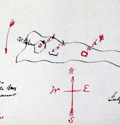| | Thumbnail | | Creator | Date | Title / Author / Date / Location | Price | | | Description |
| 4920 |  | Details | Ruger, General Thomas H. | 1895 |
| Manuscript plans of Harbor Defenses, U.S. Department of the East |
|
Ruger, General Thomas H. |
|
| 1895 |
| LOC:0 |
| $6,000.00 | Ruger--General-Thomas-H- | Manuscript-plans-of-Harbor-Defenses--U-S--Department-of-the-East | One lot with 19 pen and ink manuscript plans (7" x 11.5") of U.S. harbor defenses with artillery at various ports from Portland, Maine to the Mississippi River including Pensacola, Key West, and Charleston. Data on the artillery includes the location and type of armament including the 16″ BLR (breech loading rifle), 12″, 10″, 8″ BLR, Dynamite Guns, 12″ Mortars, and quick loading guns. From a collection of the papers of General Thomas Ruger, late in his career.
<br></br>
In 1886 the Board of Fortifications, led by Secretary of War William C. Endicott, issued a report (Endicott Report) on the need for changes to the armament along the coastal forts of America. The use of mortared brick walls and smoothbore cannon were outdated.
<br></br>
Endicott era forts were constructed with concrete walls that concealed large, breech-loading rifled artillery guns mounted on "disappearing carriages". These carriages allowed the new, rifled cannons to be raised above the walls, aimed, and fired, and then quickly retrieved back into position. (Source: https://www.nps.gov/gate/learn/historyculture/endicotteradefenses.htm)
<br></br>
Along with the 19 charts are six spreadsheets containing tabular compilations of the count and size of artillery at each location. Includes a personal letter to Ruger from his papers.
<br></br>
Thomas H. Ruger (1833-1907) was born in New York and grew up in Wisconsin. Ruger graduated the U.S. Military Academy in 1854. He was commissioned in the Wisconsin Volunteers during the Civil War; wounded at the Battle of Antietam and participated in eastern battles such as Chancellorsville and Gettysburg, before being transferred to Sherman’s Army and the famous march to the sea. Following the Civil War, Ruger was military governor of Georgia, Superintendent at West Point, and commanding general of the Department of the East from 1895-1897.
<br></br>
See Endicott Report online : https://babel.hathitrust.org/cgi/pt?id=njp.32101059089340&view=1up&seq=7 |